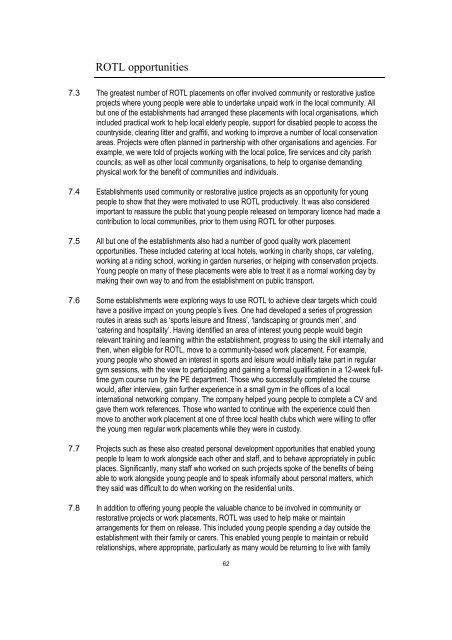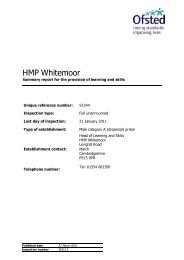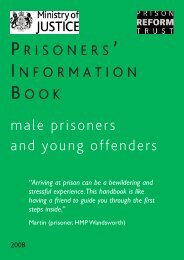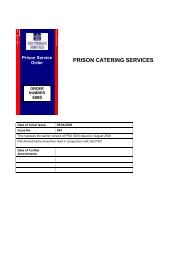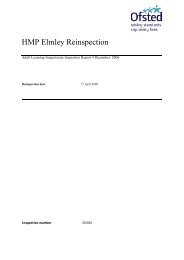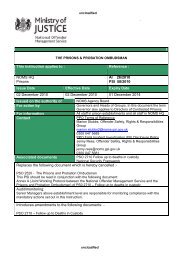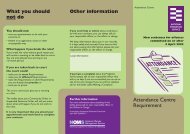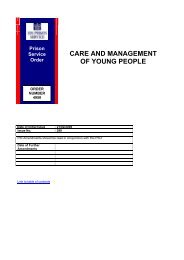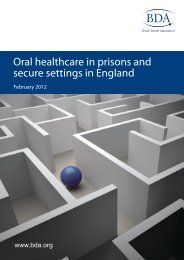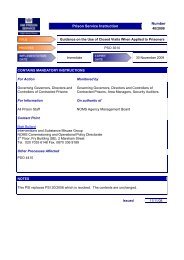Resettlement provision for children and young ... - Ministry of Justice
Resettlement provision for children and young ... - Ministry of Justice
Resettlement provision for children and young ... - Ministry of Justice
You also want an ePaper? Increase the reach of your titles
YUMPU automatically turns print PDFs into web optimized ePapers that Google loves.
ROTL opportunities<br />
7.3 The greatest number <strong>of</strong> ROTL placements on <strong>of</strong>fer involved community or restorative justice<br />
projects where <strong>young</strong> people were able to undertake unpaid work in the local community. All<br />
but one <strong>of</strong> the establishments had arranged these placements with local organisations, which<br />
included practical work to help local elderly people, support <strong>for</strong> disabled people to access the<br />
countryside, clearing litter <strong>and</strong> graffiti, <strong>and</strong> working to improve a number <strong>of</strong> local conservation<br />
areas. Projects were <strong>of</strong>ten planned in partnership with other organisations <strong>and</strong> agencies. For<br />
example, we were told <strong>of</strong> projects working with the local police, fire services <strong>and</strong> city parish<br />
councils, as well as other local community organisations, to help to organise dem<strong>and</strong>ing<br />
physical work <strong>for</strong> the benefit <strong>of</strong> communities <strong>and</strong> individuals.<br />
7.4 Establishments used community or restorative justice projects as an opportunity <strong>for</strong> <strong>young</strong><br />
people to show that they were motivated to use ROTL productively. It was also considered<br />
important to reassure the public that <strong>young</strong> people released on temporary licence had made a<br />
contribution to local communities, prior to them using ROTL <strong>for</strong> other purposes.<br />
7.5 All but one <strong>of</strong> the establishments also had a number <strong>of</strong> good quality work placement<br />
opportunities. These included catering at local hotels, working in charity shops, car valeting,<br />
working at a riding school, working in garden nurseries, or helping with conservation projects.<br />
Young people on many <strong>of</strong> these placements were able to treat it as a normal working day by<br />
making their own way to <strong>and</strong> from the establishment on public transport.<br />
7.6 Some establishments were exploring ways to use ROTL to achieve clear targets which could<br />
have a positive impact on <strong>young</strong> people’s lives. One had developed a series <strong>of</strong> progression<br />
routes in areas such as ‘sports leisure <strong>and</strong> fitness’, ‘l<strong>and</strong>scaping or grounds men’, <strong>and</strong><br />
‘catering <strong>and</strong> hospitality’. Having identified an area <strong>of</strong> interest <strong>young</strong> people would begin<br />
relevant training <strong>and</strong> learning within the establishment, progress to using the skill internally <strong>and</strong><br />
then, when eligible <strong>for</strong> ROTL, move to a community-based work placement. For example,<br />
<strong>young</strong> people who showed an interest in sports <strong>and</strong> leisure would initially take part in regular<br />
gym sessions, with the view to participating <strong>and</strong> gaining a <strong>for</strong>mal qualification in a 12-week fulltime<br />
gym course run by the PE department. Those who successfully completed the course<br />
would, after interview, gain further experience in a small gym in the <strong>of</strong>fices <strong>of</strong> a local<br />
international networking company. The company helped <strong>young</strong> people to complete a CV <strong>and</strong><br />
gave them work references. Those who wanted to continue with the experience could then<br />
move to another work placement at one <strong>of</strong> three local health clubs which were willing to <strong>of</strong>fer<br />
the <strong>young</strong> men regular work placements while they were in custody.<br />
7.7 Projects such as these also created personal development opportunities that enabled <strong>young</strong><br />
people to learn to work alongside each other <strong>and</strong> staff, <strong>and</strong> to behave appropriately in public<br />
places. Significantly, many staff who worked on such projects spoke <strong>of</strong> the benefits <strong>of</strong> being<br />
able to work alongside <strong>young</strong> people <strong>and</strong> to speak in<strong>for</strong>mally about personal matters, which<br />
they said was difficult to do when working on the residential units.<br />
7.8 In addition to <strong>of</strong>fering <strong>young</strong> people the valuable chance to be involved in community or<br />
restorative projects or work placements, ROTL was used to help make or maintain<br />
arrangements <strong>for</strong> them on release. This included <strong>young</strong> people spending a day outside the<br />
establishment with their family or carers. This enabled <strong>young</strong> people to maintain or rebuild<br />
relationships, where appropriate, particularly as many would be returning to live with family<br />
62


